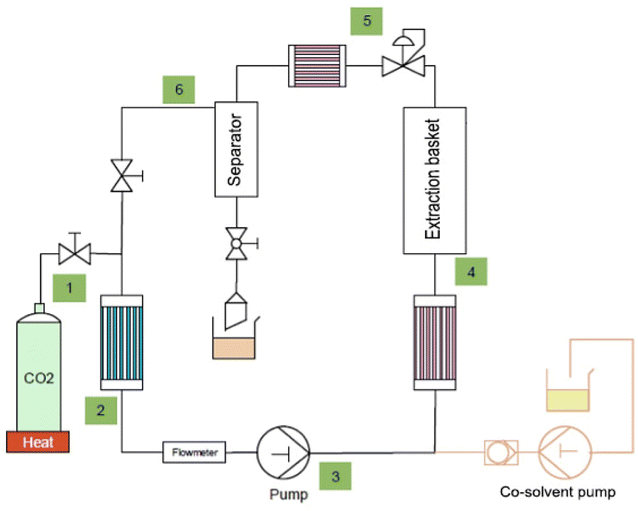
方案摘要
方案下载| 应用领域 | 食品/农产品 |
| 检测样本 | 水果 |
| 检测项目 | |
| 参考标准 | 无 |
受有机废物价值化概念的启发,并朝着可持续经济的方向发展,一种涉及超临界二氧化碳(SC-CO2)和水作为共溶剂的绿色化学提取技术被用于酿酒厂的主要副产品(葡萄渣)。目的是选择性地提取高附加值的分子,特别是酚类化合物和多糖。实验设计涉及应用三种不同的温度条件(40、60和80°C)和400bar的恒压。在SC-CO2提取物中检测到含有低甲氧基(%DE=23)果胶物质的酚类化合物和高分子量分离物(449-478 kDa),用水作为共溶剂
Inspired by the concept of organic waste valorisation and heading towards a sustainable economy, a green chemistry extraction technique involving supercritical carbon dioxide (SC-CO2) along with water as a co-solvent was employed for the main winery by-product (grape pomaces). The objective was to selectively extract high-value added molecules, in particular phenolic compounds and polysaccharides. The experimental design involved applying three distinct temperature conditions (40, 60, and 80 °C), and a constant pressure of 400 bar. Phenolic compounds and high-molecular weight isolates (449–478 kDa) containing low methoxyl (% DE = 23) pectic substances were detected in the SC-CO2 extracts accompanied by water as a co-solvent. The phenolic acids, namely, gallic (GA), protocatechuic (PCA), coumaric (CouA), and caftaric (CTA), and flavonoids, namely, procyanidin B1 (PRC B1), procyanidin B2 (+) (PRC B2), (+) catechin (CT), and (−) epicatechin (ECT) were found in all the extracts under the tested experimental conditions. The following study underscores the potential of the pressurized CO2/H2O medium as an effective solvent with minimal environmental impacts for the comprehensive valorisation of the main winery by-product, specifically targeting polysaccharides and phenolic compounds.
受有机废物价值化概念的启发,并朝着可持续经济的方向发展,一种涉及超临界二氧化碳(SC-CO2)和水作为共溶剂的绿色化学提取技术被用于酿酒厂的主要副产品(葡萄渣)。目的是选择性地提取高附加值的分子,特别是酚类化合物和多糖。实验设计涉及应用三种不同的温度条件(40、60和80°C)和400bar的恒压。在SC-CO2提取物中检测到含有低甲氧基(%DE=23)果胶物质的酚类化合物和高分子量分离物(449-478 kDa),并伴有水作为共溶剂。在测试的实验条件下,所有提取物中都发现了酚酸,即没食子酸(GA)、原儿茶酸(PCA)、香豆酸(CouA)和咖啡酸(CTA),以及黄酮类化合物,即原花青素B1(PRC B1)、原花青素B2(+)(PRC B2)、儿茶素(CT)和表儿茶素(ECT)。以下研究强调了加压CO2/H2O介质作为一种有效溶剂的潜力,该溶剂对环境的影响最小,可全面稳定主要酒厂副产品,特别是针对多糖和酚类化合物。
···
The standards of white wine-related phenolic compounds such as gallic, protocatechuic, hydroxybenzoic, caftaric, gentisic, caffeic, coumaric, and chlorogenic acids and hydroxytyrosol, tyrosol, procyanidin B1, B2, (+) catechin and (−) epicatechin were purchased from Sigma-Aldrich (Steinheim, Germany). The monosaccharide standards (mannitol, L-fucose, L-rhamnose, L-arabinose, D-galactose, D-glucose, D-mannose, D-xylose, D-galacturonic and glucuronic acids) were purchased from Acros Organics and Sigma-Aldrich. Sodium hydroxide (NaOH) solution 46/48% (Fisher Bioblock), sodium acetate (NaOAc) (Sigma-Aldrish), trifluoroacetic acid (TFA) (Merck) and all the above-mentioned chemicals were of analytical grade.
本研究中使用了超临界SC-CO2机器(SFE process, Nancy, France),该机器配有两个泵,主CO2泵和共溶剂泵,最大压力容量为1000bar。该仪器配备了一个容量为100毫升的提取器(不锈钢)和一个高压釜,将提取物引导到背压调节器(BPR)(图1)。冷却系统充满甘油,CO2流在系统中循环。得益于透明的蓝宝石隔膜,可以观察到提取物。系统中放置了各种温度传感器,用于监测系统内的重要温度变化。



动态控制气调有助于减少梨果采后病害
两种Δ8-四氢大麻酚纳米乳液制剂在大鼠体内的药代动力学
使用OPTIC-IMS热解吸-离子迁移谱系统对药物氯吡格雷进行清洁验证
相关产品

关注

拨打电话

留言咨询